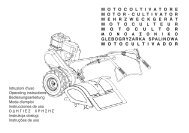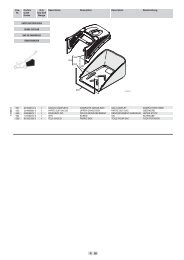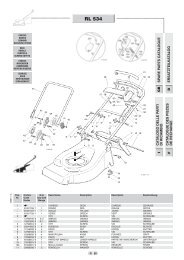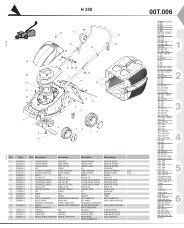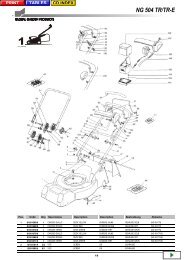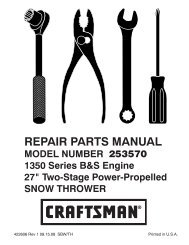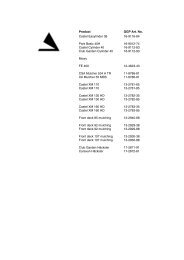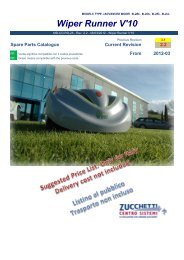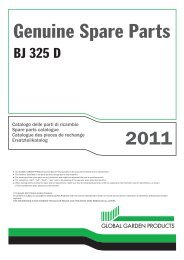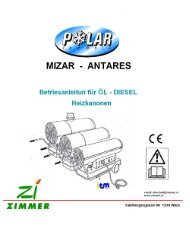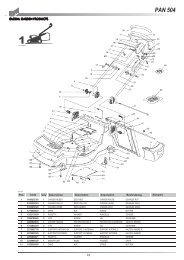MCS China LTD
MCS China LTD
MCS China LTD
Create successful ePaper yourself
Turn your PDF publications into a flip-book with our unique Google optimized e-Paper software.
IT<br />
GB<br />
DE<br />
ES<br />
FR<br />
NL<br />
PT<br />
DK<br />
FI<br />
NO<br />
SE<br />
PL<br />
RU<br />
CZ<br />
HU<br />
SI<br />
TR<br />
HR<br />
LT<br />
LV<br />
EE<br />
RO<br />
SK<br />
BG<br />
GR<br />
CN<br />
►►8. HEAT CAPACITY<br />
REGULATION<br />
Depending on the type of generator, the<br />
appliance heat capacity can be regulated.<br />
The heat capacity can be regulated by<br />
acting on the knob positioned on the<br />
base of the generator (Fig. 22) or on<br />
the pressure regulator installed on the<br />
gas cylinder (Fig. 23), depending on the<br />
model.<br />
►►9. SWITCH-OFF FOR MANUAL<br />
MODELS (... kW / ... kW R / ... kW<br />
DV)<br />
►9.1.Close the gas cylinder (Fig. 24).<br />
►9.2.Leave the fan to cool for about 60<br />
s, in order to prevent internal damage<br />
due to overheating (generator internal<br />
cooling).<br />
►9.3.Take the “O/I” switch to position “O”<br />
(Fig. 25).<br />
►9.4.Disconnect the generator from the<br />
mains electricity (Fig. 26).<br />
►9.5.Disconnect the generator from the<br />
gas supply pipe (Fig. 27-28-29).<br />
►►10. SWITCH-OFF FOR<br />
ELECTRONIC MODELS (... kW E)<br />
►10.1.Take the “O/I” switch to position<br />
“O” (Fig. 25). The fl ame goes out and the<br />
generator performs the post-ventilation<br />
phase. Wait for the cycle to be completed<br />
in order to prevent internal damage due<br />
to overheating (the phase is automatic<br />
and can last 50 s÷5 min depending on<br />
the internal/external temperature at the<br />
generator).<br />
►10.2.Close the gas cylinder (Fig. 24).<br />
►10.3.Disconnect the generator from<br />
the mains electricity (Fig. 26).<br />
►10.4.Disconnect the generator from<br />
the gas supply pipe (Fig. 27-28-29).<br />
N.B.: do not disconnect the generator<br />
from the mains electricity, before the<br />
end of the post-ventilation phase, in<br />
order to prevent internal damage due<br />
to over-heating.<br />
►►11. CLEANING AND<br />
MAINTENANCE<br />
Have the after-sales assistance check<br />
correct functioning of the generator at<br />
least once a year and/or as required. The<br />
appliance must be cleaned before it is<br />
put away after use.<br />
►11.1.Before starting any type of<br />
maintenance, care and repairs of the<br />
appliance, carry out the switch-off<br />
sequence [Par. 9. “SWITCH-OFF FOR<br />
MANUAL MODELS (... kW / ... kW R /<br />
... kW DV)” or “10. SWITCH-OFF FOR<br />
ELECTRONIC MODELS (... kW E)”].<br />
►11.2.Cleaning only concerns the air<br />
vent (rear side) of the generator.<br />
►11.3.When the appliance is used<br />
again, check the state of integrity of the<br />
gas hose and power supply cable. If in<br />
doubt regarding their integrity, request<br />
the assistance of the technical after-sales<br />
service.<br />
►11.4.Do not carry out unauthorised<br />
interventions.<br />
►►12. ROOM THERMOSTAT<br />
CONNECTION (... kW E)<br />
(optional)<br />
Remove the plug connected to the<br />
appliance and connect the room<br />
thermostat (optional) (Fig. 30).<br />
See wiring diagram (... kW E).



